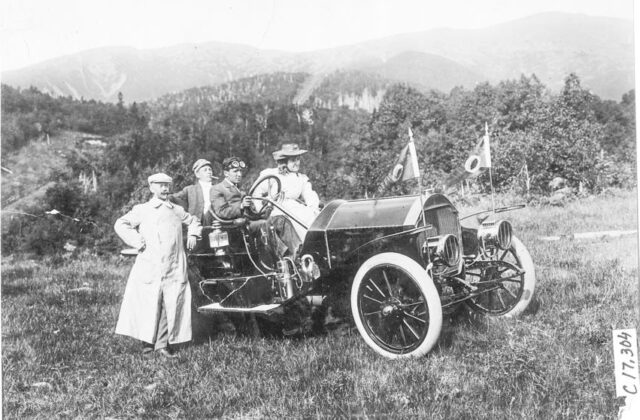Early Automobilists Find Their Way to Norfolk
By Andra Moss
Just when travel seemed so modern—the Mountain Express train barreled along from Hartford to Canaan at speeds up to 37 miles per hour—something new came clanging, hissing and rattling over the hilltops.
It was 1900. American automaking was still in its infancy, but change was coming fast (“fast” being a relative term; in 1901, Connecticut set the first statewide speed limits at 12 m.p.h. on city streets and 15 m.p.h. on country roads).
By 1902, the Automobile Club of Hartford was holding regular runs of 30 to 40 miles. Thomas Morse opened an automobile storage business in downtown Lenox. And Norfolk? Let’s just say Norfolk was not an early adopter.
The Hartford Courant noted in August 1908 that “for a great many years Norfolk has taken a certain place among summer resorts as being the last to know the invasion of the automobile. . . . Long, long after all the Sound and seashore resorts had become inured to the motor, Norfolk knew none of it. To be honest, it must be admitted that a potent reason for this was not so much loyalty to the horse as the almost perpendicular Norfolk hills and her deep sand roads.”
Apparently, even Canaan knew the automobile before Norfolk, but at last, The Courant reported, “when the 6 o’clock train comes in from New York it finds waiting . . . Packards and Panhards . . . even the sacred fastnesses of the woods around Lakes Doolittle and Wangum are never free from the horn of the monster.”
While the town may have been late to the party, by 1908 Norfolk was ready to roll. One especially enjoyable pastime was the “touring party,” automobile excursions made possible by significant improvements that year to the road to Litchfield “at a cost of $8,000 for 4,000 feet.”
Throughout the summer of 1908 The Hartford Courant reported that “the automobile parties are increasing day by day . . . most have Great Barrington and the Berkshires as either a goal or a starting point. . . . The Norfolk Inn has been turning away five and six parties a day.”
By June 1909, The Courant was singing the praises of paving: “One of the first improvements noticed by the returning visitor is the macadamizing of Maple Avenue. The work adds greatly to the attractiveness of this fashionable street and is to be carried on to the intersection of Laurel Way and Greenwoods Road.” (Developed by Scotsman John McAdam, “macadamized” roads were covered with compacted layers of gravel and broken stone.)
With advancement came conflict between past and present, as in this 1909 incident after a chauffeur started his car beside a horse enjoying a bag of oats: “Never had he halted, run or faltered, but to have an auto break rudely into his dinner in that fashion was too much and off went Dobbin. Down the Shepard road he tore, the big wagon tossing behind him and the oat bag flopping from his chin. Faster he went through Emerson Place, under the railroad tracks and into the main street.” Poor Dobbin finally came to a halt, trembling, in the doctor’s yard.
But there was no turning back. Norfolk was now on the map, literally. American Motorist magazine of 1910 includes it as a town to visit on the “Ideal Tour” from New York City to the White Mountains. Seeing opportunity, the Norfolk Inn advertised in the magazine as early as 1912, and local society pages regularly listed arriving inn guests by name and city.
With so many “automobilists” heading to Norfolk, Augustus P. Curtiss opened a garage on Shepard Road that leased touring cars by the day or week. The Norfolk Fire Department was motorized around 1914-15 when it was gifted a chemical engine and an automobile. Ford’s “Tin Lizzies,” REO Speedsters and the deluxe cars of the “summer people” all shared the roads of Norfolk, in the words of local press, “without the slightest consideration for law or reason.”
In 1917 Norfolk’s own Robbins B. Stoeckel became Connecticut’s first commissioner of motor vehicles. That first year, the motor vehicle department registered 92,605 vehicles and licensed over 100,000 drivers.
The horseless carriage was here to stay.
Photo courtesy of the Detroit Public Library Digital Collection

